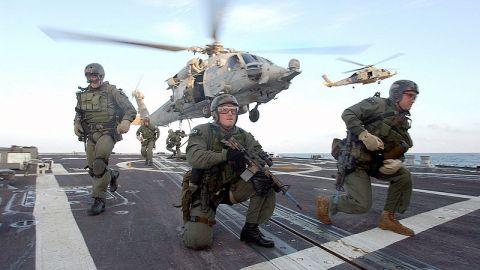How Big is the Navy SEAL Innovation Multiplier?

Now that we’ve had time to reflect on the daring attack on Osama Bin Laden’s Pakistani compound by Navy SEAL Team 6, it’s been fascinating to hear about all the state-of-the-art military technologies that were deployed as part of the raid. There were tricked-out Black Hawk helicopters, unmanned robo-copters, stealth drones and satellite-linked camera feeds relaying live-action reports to military command posts in the U.S. And don’t forget the bulletproof, armor-plated dogs. Obviously, an awful lot of military expenditure went into equipping these brave Navy SEALS with the best, most innovative equipment on the planet — the kind of stuff that excites the average person on the street as much as a WIRED magazine or Popular Science reader. So just how big is the Navy SEAL innnovation multiplier?
Let’s unpack the concept of the multiplier for a second. A multiplier is just a way of saying that every dollar of expenditure leads to some additional amount of incremental growth, typically measured in terms of GDP or some other conventional economic variable. The logic behind the multiplier is what gave us the great taxpayer rebate of 2009: the US government gives every taxpayer $250, fully expecting that some percentage of that amount gets spent at a local business, which in turn, benefits from that incremental spending and decides to hire additional workers, who in turn now have more money to spend, so they spend money at a local business… Well, you get the idea.
So, an innovation multiplier is just a way to measure the amount of incremental innovation that occurs as a result of every dollar of U.S. Defense Department spending on projects like the Navy Seal attack on Bin Laden. The Navy SEAL Team 6 multiplier may be bigger than you think, especially if it leads to a robotics revolution, as suggested by the Wall Street Journal and experts like P.W. Singer, who wrote the New York Times bestseller Wired for War: The Robotics Revolution and Conflict in the 21st Century. That’s big, if the Defense Department can jump-start the U.S. robotics industry, bring robotics into the realm of everyday life, and transform robotics into an innovation driver alongside the Internet. Every dollar of Defense spending gets parlayed into something much bigger.
But robotics is just the start.There are also opportunities to create advanced surveillance technologies, to develop new high-performance clothing materials and to create advanced hyperspectral sensors. Each of these technologies, originating in the defense sector, has the potential to migrate to the consumer sector.
The innovation multiplier concept is important in that it gets us thinking about platforms rather than products. It’s like the NASA manned space exploration missions – so many people focus on the real-world products that resulted from years of space exploration (yum, Tang orange juice!) rather than the technological platforms that paved the way for radically new types of innovation. Years from now, when the robotics revolution comes to pass, we may be able to thank Cairo the bulletproof dog for more than just giving every American Fido the chance to walk around the block in a nice $30,000 piece of body armor.
[image: US Navy SEALS Fast Rope via Wikimedia Commons]





